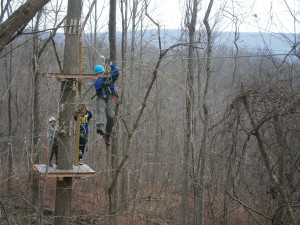During a recent outdoor activity, the author requested that one of the activity stations be modified (by reducing the height at which the activity occurred) to provide a greater margin for safety, this despite the activity being within the guidelines specified in the Guide to Safe Scouting.
 The point of the requested modification was that the thrill and challenge of the activity was the same irrespective of the height at which the activity occurred.
The point of the requested modification was that the thrill and challenge of the activity was the same irrespective of the height at which the activity occurred.
Again, while within the parameters of the Guide to Safe Scouting, reducing the height lowered the magnitude of risk without affecting the enjoyment and challenge of the activity for the youthful participants.
The original choice of height was presumably made by an adult volunteer based on a height at which the adult believed was necessary to optimize the activity, which did not necessarily correlate to the needs or perceptions of the participants.
Probably a common decision-making process, such as might occur during an outdoor activity. However, from a risk management standpoint, particularly with younger Scouts, it serves no purpose to conduct an activity at a level of risk that exceeds that necessary to accomplish the desired result, provide the necessary challenge, and achieve a sense of accomplishment and enjoyment!
Instead, the challenge of the activity, and the associated magnitude of risk, should be matched to the age, maturity, and experience level of the participants, while still meeting the desired goals of the activity.
